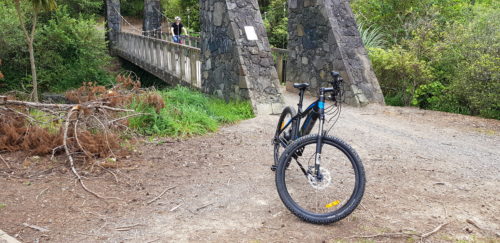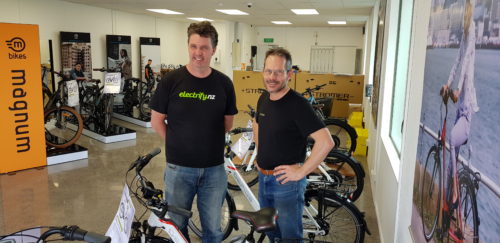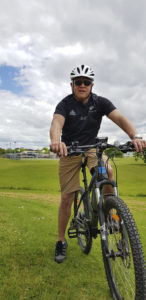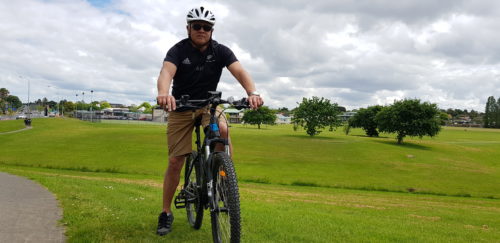
E-bikes are making huge inroads in the recreational and adventure markets in NZ with growth rising from 1800 coming in for the whole of 2015 to some 2000 per month. Times editor Nick Krause takes a test ride to see what the fuss is about
Hardcore mountain bikers, please look away. If you can’t resist reading on though, please keep an open mind – don’t be haters.
E-bikes have won me over, specifically the mountain bike I test rode, the Magnum Peak.
My leisure time is normally spent tramping but I do get the mountain bike out for some outdoor fun which has taken me to a lot of tracks all over the place.
Both of these pursuits get me outside and test me and my endurance and, certainly with tramping, can mean a few hours in the bush in the middle of nowhere.
And like mountain biking, they really test your legs (not to mention resolve) in hill country. There is a good deal of masochism at play here. I know what I’m doing is going to hurt, perhaps for days, and yet it still gets me out there for a crack.
Out on my mountain bike, I’ve seen more of these e-bikes out there, whirring past me on inclines, me with a good, honest sweat going on as I clock up the ks. Surely that’s defeating the purpose, cheating even. My consternation had never wavered.
Enter Electrify NZ, the country’s biggest e-bike specialist founded by Michael Tritt, a regular cyclist and sustainability advocate for two decades (he was very high up in Greenpeace).

Their newest store – the eighth in the country – has opened in Botany and is owned by Anthony Cooke (a ninth store is to open on December 1 in Christchurch).
So I asked to test one of these abominations.
We rode a short 10km round trip from near Cascades Road bridge to Pakuranga College. The bikes are heavier than conventional bikes. Electric bikes are built more robustly to handle the extra power (a motor and battery) and the extra weight.
I did switch to zero assistance to get a feel of the bike. Pretty good balance I have to say and I rode under my own steam a couple of times (once on a gravel uphill climb). Couldn’t really feel the difference.
But I couldn’t help myself and opened up where I could (I wound right down on blind corners and where visibility was compromised). Wow. You cycle and, depending on the assistance on dial in, the silent motor kicks in without breaking a revolution on the pedals. Gloriously insane.
On my conventional bike the only time I even think about speed is on a downhill run, and that’s really more about braking and control.
This electric bike is amazing. I cranked it up as high as I could go and hit 43-46km/h. I switched to a commuter bike, a lot more comfy and more seamless on gear changes. Hit 38km/h before going back to the Magnum.
Speed obviously will clearly require more juice and impact your range.
That really doesn’t matter. It will have battery power to satisfy even the most adventurous.

Yes, 50-70km is eminently achievable on all our e-bikes. Careful riding can see a single charge last 100km, rather than the usual 70km on a mid-range bike while 150km is possible on the store’s top-end bikes.
Even on my keenest day on my old bike, 30-40km was my limit (15-20km my usual).
And hills. Too easy. I’m riding like I’m on the flat.
So what’s the point? Am I even getting exercise, copping the burn?
The burn wasn’t there but I had a light sweat and breath marginally laboured – but I did push as hard and as fast as I could. I can live with this. Seriously.
But is this a passing phase? I don’t think so. The growth of e-bikes (according to transport consulting firm Via Strada estimates for NZ) show in 2015, an estimated 1833 e-bikes were brought into the country. In the year to May 2017, that number jumped to nearly 17,000.
This year, that number has increased to almost 2000 electric bikes per month.
“Another interesting statistic from overseas, one in three bikes sold in The Netherlands each year now is an e-bike,” says Cooke, whose Botany store has a range to suit everyone.
I balked at the prices I’d seen last year on some e-bikes. This seems to be settling down.
Naturally cost is higher (electric motor, battery and manufacturers need a better base bike to start with) but I could live with this range – perhaps not top-end (although I really would to try one out).

Electrify NZ stocks mid and high-end bikes, retailing from $2.5k to $8.5k.
“The benefits compared to a regular bike are you can ride without getting all hot and sweaty but you do still get some exercise,” says Cooke.
“It makes headwinds and hills irrelevant and, because it’s easier, you’ll tend to ride further and more frequently.”
But also, they’re fun, just exhilarating. They democratise bike riding, says Cooke.
“You don’t have to be a lycra-wearing, life-long cyclist to enjoy an e-bike. You can e-bike to work in your suit or your dress, and you won’t need a shower or a change of clothes when you get there.
E-bikes can be as fast – or faster – for some commuters, compared to a car sitting in traffic going nowhere.
Think Pakuranga Highway, Te Irirangi Drive, Mt Eden, the City, the North Western Motorway path.
I’m sold.










